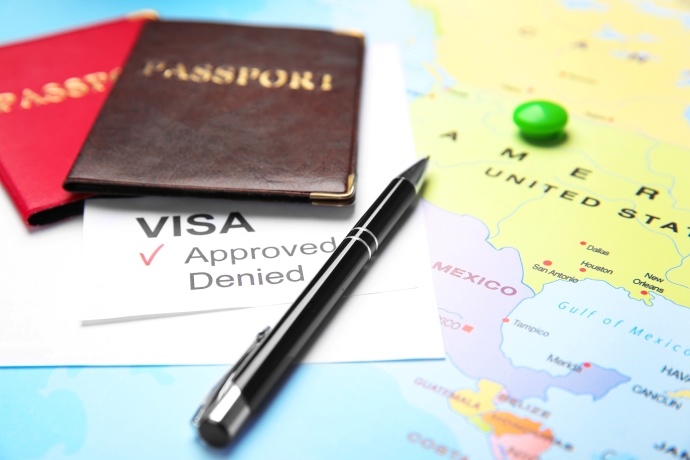Procedures To Apply For A Working Visa In The U.S.
The United States is one of the leading destinations for individuals seeking employment opportunities and a high standard of living. For those who desire to work in the U.S., obtaining a Working Visa is a crucial step in the process. The type of Work Visa you will require depends on the nature and duration of your intended work in the US, as well as your qualifications and skills.
The process of obtaining a Working Visa can be complex and time-consuming, but with proper guidance, it can be a smooth and straightforward process. By obtaining a Working Visa, you will have the opportunity to work and live in the United States and contribute to its dynamic and diverse economy.
Select The Correct Working Visa To Apply For
If your goal is to establish a long-term presence in the United States, an employer-sponsored Green Card is a good solution for you. Each year, the U.S. government issues approximately 140,000 Green Cards to foreign nationals through this program, offering them the opportunity to live and work in the country on a permanent basis.
Having a Green Card allows you to work in the U.S. and provides numerous other benefits, including the eligibility to apply for citizenship, travel freely, and access certain government-funded programs. To be eligible for an employer-sponsored Green Card, you must have a job offer from a U.S. employer, and the employer must be willing to sponsor your Green Card application.
If you are not ready to make a permanent commitment to the United States, you may want to consider a temporary Work Visa, such as the H-B1 Work Visa. This type of Visa is designed for individuals who wish to work in the U.S. on a temporary basis, typically for a period of three years or less. H-B1 Work Visas are generally used by individuals with specialized skills, such as engineers, scientists, or managers.
Know more about temporary working visa here
How To Apply For An H-B1 Work Visa
For individuals with a bachelor’s degree and specialized knowledge or training, searching for employment opportunities in the United States may lead to the option of applying for an H-B1 Work Visa.
To be eligible for this, the prospective employer must demonstrate the absence of suitable domestic candidates for the offered position, and the applicant must provide evidence of their college degree or equivalent qualification. The petition for the H-B1 Visa must be filed by the employer through the United States Citizenship and Immigration Services or USCIS online system.
It is important to note that, unlike certain other types of Visas that may be directly applied for through the USCIS, the H-B1 Visa petition must be submitted on behalf of the applicant by the prospective employer. The process of obtaining a Working Visa can be complex and requires careful consideration and attention to detail. For this reason, it is highly recommended to seek assistance from an immigration lawyer to ensure a properly executed Visa application.
Alternative Non-Immigrant Work Visas
Foreign citizens seeking work opportunities in the United States may be familiar with the H-B1 Work Visa, one of the most commonly applied for non-immigrant Work Visa. The H-1B Visa is designed for foreign nationals who have a job offer from a U.S. employer in a specialty occupation, such as technology, engineering, or finance. However, it is important to note that several other non-immigrant Work Visas exist, each with its own specific eligibility requirements and limitations.
For example, the H-2A Visa is designed for individuals seeking seasonal employment in the agriculture industry, while the H-2B Visa caters to those seeking seasonal employment outside of agriculture. Both of these Visas are temporary in nature and are suitable for individuals seeking temporary work in the United States.
It is important to carefully research and understand the requirements and limitations of each non-immigrant Work Visa before making a decision on which one to apply for. Factors such as the type of job being offered, the duration of employment, and the individual’s qualifications and skills must be taken into consideration when choosing a Work Visa.
How To Apply For An Employer-Sponsored Green Card
For those individuals who have made the decision to relocate permanently to the United States, obtaining a job offer from a U.S.-based employer is a crucial first step. In most cases, the potential new employer will need to file an I-140 immigrant petition with the United States Citizenship and Immigration Services on behalf of the foreign national.
The I-140 petition is a critical component of the Green Card process, as it establishes the foreign national’s eligibility for a Green Card based on their employment in the United States. This process can be complex and time-consuming, and it is crucial to seek the guidance of an experienced immigration lawyer to ensure the petition is complete and meets all necessary requirements.
In addition to the I-140 petition, foreign nationals seeking a Green Card through employment must also undergo a medical examination and complete security background checks. In addition, they must demonstrate their ability to support themselves and their dependents financially during their time in the United States.
Primary Preference Groups For Employer-Based Green Card Applicants
As previously noted, individuals who have demonstrated extraordinary abilities in their field are given first priority in the Green Card application process. This typically encompasses professionals, academics, researchers, scientists, and those in the entertainment industry.
For those with an advanced degree higher than a bachelor’s, such as a master’s or doctorate, or a minimum of 10 years of professional experience, eligibility as a second preference applicant may be possible.
Individuals with a bachelor’s degree or skilled or unskilled laborers are considered third-preference applicants, having a lower likelihood of being granted a work-based Green Card compared to those in the first two categories.
Lastly, the fourth preference category applicants seeking residency who have a lower probability of obtaining a Green Card compared to the previous groups. For example, religious workers, employees of a U.S. foreign service post, or retired employees of an international organization.
Information That You Should Provide To Your Potential New Employer
It is advisable to gather the information that may be useful for your potential employer when filling out your immigration petition. In order to increase the chances of a successful application, it is recommended that you provide your potential employer with relevant supporting documents.
This may include transcripts of your academic records, certified copies of your educational qualifications, and any professional licenses or certifications relevant to the job position you are applying for. Additionally, providing proof of your work experience, professional references, and a detailed job description may also enhance the strength of your application.
It is important to note that the USCIS requires a substantial amount of information and documentation when processing immigration petitions; therefore, it is essential to be proactive and assist your employer in providing all the necessary information to support your application.
What Your Potential Employer Must Provide To The USCIS
It is important to note that in addition to your educational and professional qualifications, your potential employer will also have to provide sufficient evidence to support the validity of your offer of employment. This includes demonstrating that there is a lack of suitable domestic candidates for the role you have been offered and that they have the financial means to provide a reasonable salary for the position.
Furthermore, they may be required to provide information such as the business’s financial records and a detailed job description outlining the duties and responsibilities of the role. As a foreign national, it is in your best interest to ensure that your potential employer has gathered all necessary documentation and information to ensure the smooth and successful processing of your Work Visa application.
Why Hire An Immigration Lawyer From Lincoln-Goldfinch Law – Abogados de Inmigración?
Hiring an immigration lawyer from Lincoln-Goldfinch Law – Abogados de Inmigración when seeking a Working Visa in the United States is a wise decision for several reasons. Firstly, immigration laws and regulations are complex and constantly evolving, and an attorney can help you navigate the legal landscape and ensure that you meet all eligibility requirements.
Secondly, an immigration lawyer can provide you with personalized guidance and advice tailored to your specific situation, taking into account your unique circumstances and objectives.
Thirdly, an immigration attorney can represent you in your application and act as your advocate throughout the Visa application process, increasing your chances of a successful outcome.
Additionally, if you encounter any complications during the process, an immigration lawyer can provide legal support and representation to resolve the issue.
The knowledge that an immigration lawyer can bring to your Visa application can greatly increase your chances of obtaining the Visa you need to live and work in the United States. Lincoln-Goldfinch Law – Abogados de Inmigración and its team of skilled immigration lawyers can ensure that all the steps required in applying for the right visa are followed.
Contact A U.S. Immigration Attorney Today!
Categories
How To Find Us
What Our Clients Say
“This Lawfirm is great, very professional and helpful. I love that they are always in communication and always available for when you have questions . 100% recommended by me and my family. Thank you Lincoln-Goldfinch Law – Abogados de Inmigración”






